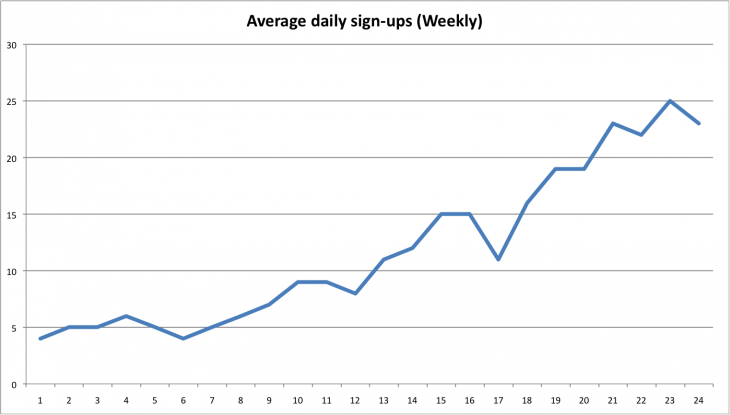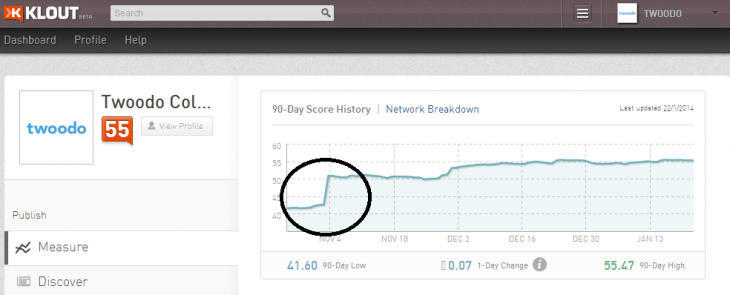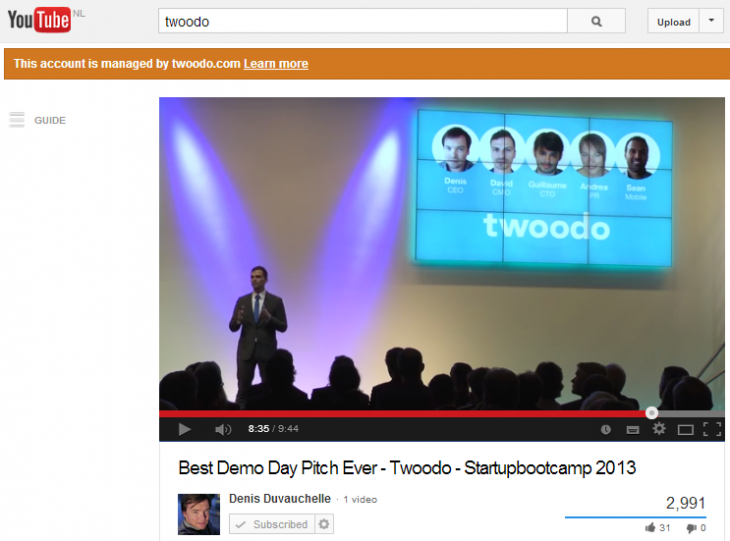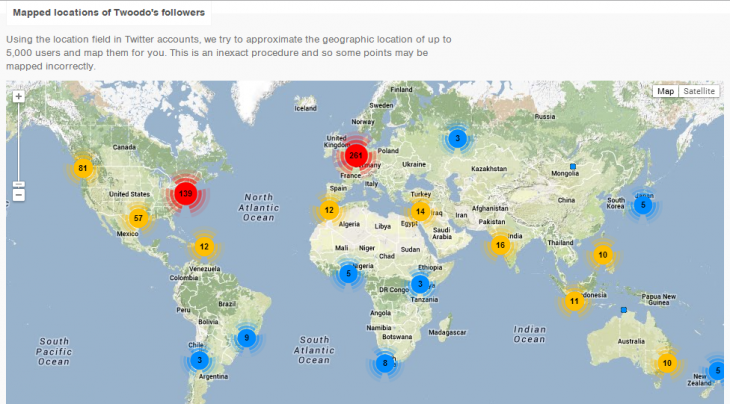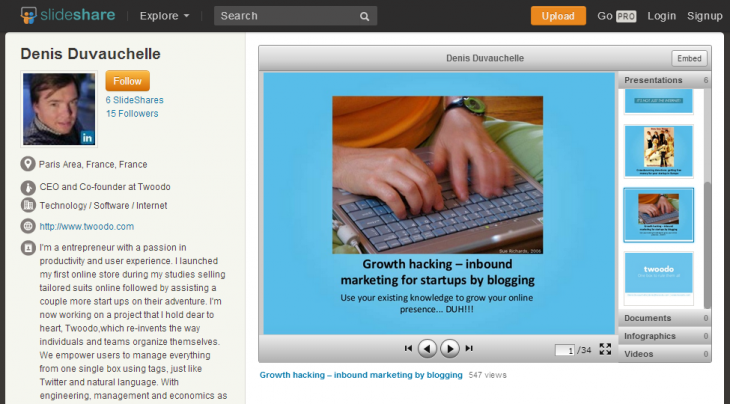
David Arnoux is Head of Growth and co-founder of Twoodo. Twoodo helps you organize everything and anything using #hashtags, giving you headspace to focus on what’s important.
Six months ago, we went from five daily sign-ups to 25. As a SaaS startup building a team collaboration tool we developed a cost-effective content marketing strategy, going through the mill of guest posting, social media marketing, content creation and applying various growth hacks.
After an intense three months at Europe’s premiere accelerator program, Startupbootcamp Amsterdam, our product was finally taking shape and we had reached product-market fit. The next step was to start acquiring more traffic.
It was important to increase sign-ups to please our investors by starting to scale but also very importantly to keep testing and fine-tuning our landing page, sign-up process, on-boarding and activation rates. We also wanted to start generating buzz by earning more early loyal users that would convert to evangelists in the future. Nothing new here.
After six months we had increased our unique visitors by 295 percent but most importantly, we increased the number of sign-ups by 400 percent.
The growth curve is steadily rising per month – not a once-off peak and then high drop-off rate. This is a healthy state to be in.
Part 1: Assume nothing – do your marketing research
It is popular knowledge that early-stage SaaS startups are not the sought-after fodder of top tech journalists. There’s a hell of a lot out there. So we didn’t start off naively assuming that we’d be appearing on Inc.com any time soon.
This is how we chose guest blogging as our primary strategy. Via a link in the author bio, plus offering good tips and advice, we hoped to draw people to Twoodo. It became, and remains, our most effective growth strategy. It wasn’t easy getting started, though.
Finding niche blogs with a decent engaged readership that matched our tested personas took a long time to research. We used Technorati, top ten blog lists and Google for hours on end trying to discover the right places.
This involved:
- checking the last 20 or so blog posts to see if the topics were relevant to readers we wanted to target
- checking how much engagement there was by looking at the level of commenting for at least five recent articles
- checking their social media following on Twitter, Facebook and LinkedIn for activity (our targets were mainly Twitter and LinkedIn for a B2C2B strategy)
- checking that they accepted articles
- checking that if they did accept articles, could we have a backlink (if not, there was no point for us to write for them)
We wanted 30 to 50 blogs where we could pitch articles to, since different blogs require different topics and styles. The team was new to this, so we weren’t sure where our knowledge would fit in best. We also wanted to have a broad reach to many communities.
What we learned:
- Few blogs have an engaged readership
- Many of the best blogs are small company blogs, not general news blogs
- There are a lot of liars out there (seriously, not all of you can be the “top,” “best” tech blog)
- SEO tricks diverted us away from the good material to the mediocre in our searching
- Places that beg for guest blog posts or rely completely on guest posts are not where you want to spend your time
- People often don’t take down dead websites
- In the end, getting on the big publications of the world really is the best for a return on your writing time since they are reputable, have a huge following and have plenty sub-categories of topics to fit into
Part 2: Distilling the data into useful stuff
Quicksprout is one of the greatest blogs on growth, and this article by Neil Patel gave us the information we needed to act upon the data we had gathered.
From the extensive research on blogs, we not only had a list of blog domains, but also bloggers, their contact details, their topics of interest and a sense of their preferred writing style. We set up a series of spreadsheets to manage all the information.
- First, we ranked the blogs from 1 – 4 (1 being the most desirable to feature on, 4 being the least)
- Second, we collected the names and emails of targeted journalists and editors on each one, noting which ones were assigned to deal with the guest posts
- Third, we collected their Twitter handles and linked up with them
- Fourth, we separated those that certainly accepted guest blog posts to those that were ambiguous (and of course, deleted those that never accept guest posts)
What we learned:
- You’ll know you’ve figured out the niche when you notice the same names appearing over and over. The people in these circles will often reference each other and use each other’s services.
- You should hit them up on Twitter when you have something interesting to share, and ask their opinion.
- Support their organizations, events and so on by liking them on FB, [re]tweeting their content and commenting on their posts.
- If they use Pinterest, you use Pinterest. If they use Quora, you use Quora. Follow them and learn more about the relevant places for you to be.
- Find out what they DON’T like and avoid it.
We created templates for everyone to use here.
Part 3: Content experiments
There are multiple forms of content marketing that you can test, but ultimately you will have to choose just a handful so that you can execute them well.
A scattered and inconsistent presence over too many channels is a waste of your time. Thankfully, there are tools to help.
It’s hard to dismiss any single channel until you have tested it thoroughly, but if your team is of a limited size you may have to do that in the early days. For example, based on our personas and early users, we assessed that Pinterest was not a useful channel for us (80 percent women, brick-and-mortar sales).
Preferably, you would run data-driven experiments with the right tools (We used Mixpanel and Google Experiments etc.) but you can also tell from social engagement if a channel is successful or not (the same with a guest blog post). In the end, we have found Twitter the best platform for sharing content, engaging with people and growing our community.
This is not so surprising for a SaaS company! This is based on the speed of how our follower base grew and the level of interaction.
Guy Kawasaki has one of the largest social media followings in the world, and based on a webinar I attended, he attributes it all down to sharing excellent content. For keeping your channels on Facebook, LinkedIn and Twitter busy, try tools such as Buffer or Hootsuite.
Naturally, we used the list of blogs we had researched to choose our content and occasionally notified authors when we shared their content via including them in a tweet. We also use AllTop, ContentGems and Prismatic to watch out for new and interesting blogs, posts and bloggers (though I did not know about them at the beginning!) as well as more content to share.
What we learned:
- Sharing content without reading it first is going to catch you out. If you tweet 10+ times per day then you are going to have to read a hell of a lot. Some people say you shouldn’t be on Twitter and only tweet a few times a day, but since finding and reading lots of good quality articles/infographics/slideshares etc. takes time, you have to make that decision.
- Learn how to hashtag – use this guide from us on The Next Web
- The same content rarely works across all channels
- Focus on a few good communities
- Keep a minimal presence on the big channels (FB, G+, LinkedIn, Twitter, Flickr/Instagram, Slideshare) so as to show an effort – it makes a difference to some people, and as your company grows you may find that a channel activates that didn’t work before
- For SEO, be on G+
- Make an effort to contribute to the most important communities to your business. When the time comes to ask for a favour
Part 4: Take advantage of everything
This is one of my personal growth hacking definitions. We tried out many different tricks depending on the situation – in some respects, you have to be shameless and “do what it takes” to get noticed! There are many “free” tools out there for the content marketer to use (I say “free” because you do need to spend precious time).
On Twitter, we grew the social media accounts of the CEO, CMO and growth guru. The CEO account curated people interested in productivity and work-life balance (the core philosophy of our company).
The CMO account focused on marketing and social media enthusiasts (since our tools is about social collaboration). The growth guru targeted growth hackers (we are going through a lot of growth experiences now and write about it frequently).
This meant three times the audience because we could appeal to three different communities. Remember not to share the same content to all these different groups – a productivity person is not going to care about user-testing tools.
We recycled old content (usually old blog posts). This maximizes the ROI of the time spent preparing great content. As mentioned previously, other channels may open up and this is a great way of getting on board without having to prepare completely new content.
- The best of the images used (that we have copyright to) are put up on Flickr or Instagram.
- Infographics could be made from some blog post material.
- We use the text and images to create slideshares.
- We make comic strips out of our landing page copy to explain the pain our product solves and use them in email campaigns.
- Once a week we check our Buffer statistics and publish a Flipboard magazine with the most popular shared content.
- We have plans to use the images to create Vines in the future if it looks like a valuable market.
What we learned:
- When converting old content, it is really useful to have some designing chops, or at least to have a good designer at hand.
- Every crazy idea is worth testing.
- Be alert to new and better tools to help you automate your marketing efforts (without damaging them).
- Decide if riding pop culture waves fits your company and audience. This is especially important for visual marketing.
- Personally thank as many people as possible when they share your content (use TweetDeck or Hootsuite for this endeavour)
Finally, the results!
-
Over the past 24 weeks our average daily sign-ups rate has increased from an average of 2 per day to around 25 per day. That’s almost a 400 percent increase and we don’t plan on letting the curb stop there.
-
Close to the top social media influencers according to Klout (a score of 63 and over puts you in the top 5 percent):
-
Our YouTube video is just about to hit 3,000 views. This might seem low but people who watch the pitch are extremely qualified leads as they have heard what the product is about and really want to start using it.
-
Reached 1,000 Twitter followers within two months, all over the world:
-
Over 2,000 views on Slideshare
-
Access to bigger and better blogs due to our portfolio of articles on past smaller blogs
You might think that the numbers are small, but you’re not looking at the bigger picture. These are targeted, high quality visitors with a high lifetime value. Our conversion rates are all above industry average.
Our future Content Marketing goals:
- Increase our Twitter follows to thousands
- Explore if visual marketing is worth spending time on
- Create an improved testing process for content marketing strategies
- Re-test Facebook and LinkedIn with a new approach
- Refine the work we are already doing (faster and better!)
- Release our own blog with a theme unique to our experience and knowledge
- Increase guest blogging on major websites
- Discover new growth hacks from fellow startups
What content marketing techniques worked or didn’t work for you? Please share!
Get the TNW newsletter
Get the most important tech news in your inbox each week.




